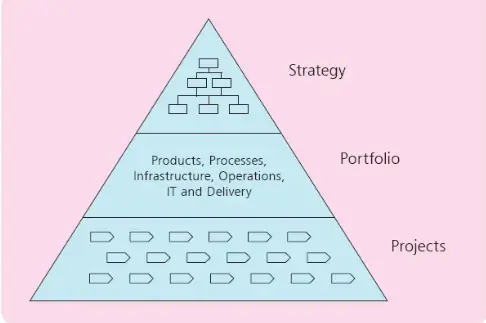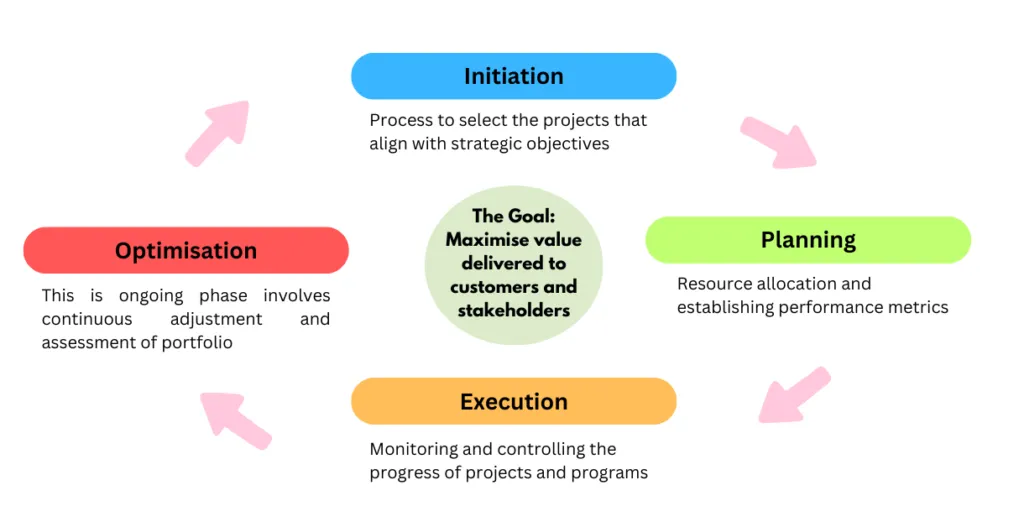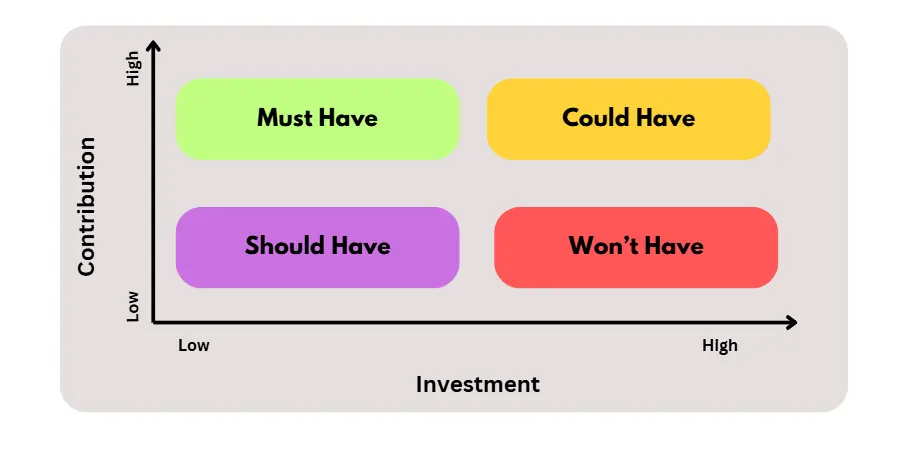The word portfolio was originally used to describe a type of briefcase, typically containing a collection of papers. The term was then extended to cover an artist’s portfolio, containing samples of artist’s work. In government, term portfolio is used to describe the post and responsibilities of head of a government department.
In the world of project management, project portfolio is used to describe the entire collection of projects in an organisation.
Project Portfolio
The project portfolio is the term used to describe the total set of programs, stand-alone projects and other change initiatives being undertaken by an organisation. The reason for creating a portfolio is to provide overall business view and control over all the programs and projects at high level in the organisation.
The Project Portfolio Management (PPM) is sometimes referred to as ‘enterprise project management’ and the goal is to ensure that the portfolio delivers is value in line with the business strategy of the organisation.
Organizations have limited resources, so they must balance conflicting demands. Portfolio management helps manage this balance and achieve business benefits.
The following diagram shows the relationship between the organisation’s business strategy, it’s portfolio and its projects:

A prerequisite for portfolio management is that the business strategy and objectives have been defined. The strategy layer represents the organisation’s vision (what it wants to be in future) at the top of the pyramid. This drives the organisations strategy and objectives.
The portfolio layer represents the sum total of all the projects, supporting processes, infrastructure, operations and delivery that will be needed to achieve the strategy and objective.
The projects layer represents the individual projects that will be executed to implement the strategy and objectives.
Enjoying the article. Go back to basics. Learn about Project Management here.
Project Portfolio Management
Portfolio Management is defined as the centralized management of processes, methods and technologies to collectively manage a group of current and proposed projects. The objectives are to determine the optimal resource mix and schedule to best achieve the organization’s operational and financial goals. This means which programs and projects to run and which not to.
Just like a mix of different investments in a portfolio, there are different projects in a project portfolio, each at various stages. These projects can be anything from making new products to improving how things work or promoting products. A common thread that is running through all these projects is alignment with business strategy.
Key Objectives of Project Portfolio Management
Without proper portfolio management, programs and projects may end up being authorized for all the wrong reasons. We would end up selecting “nice to have” programs and projects as they have some funds available.
With portfolio management, programs and projects are selected based on what they contribute to corporate objectives. Portfolio management can be summarized as having three key objectives:
- To maximize the value of portfolio by achieving the best possible return on investment.
- To align the portfolio with the organisational strategy by selecting the projects that meet the needs of the business.
- To balance the portfolio by making best possible use of the organisation’s human and financial resources.
Project Portfolio Management Lifecycle
Project portfolio management can be broken down into four basic components:
- Initiation
- Planning
- Execution
- Optimisation
These four components are represented in the diagram below

Initiation: Portfolio initiation is a critical phase in the portfolio management lifecycle. It involves the formal release of business and organizational objectives and goals, setting the foundation for how the portfolio and its components will be managed.
Planning: In this phase, detailed planning is conducted for the portfolio components. This includes resource allocation, risk management, and establishing performance metrics.
Execution: This phase involves the implementation of the portfolio components. It includes monitoring and controlling the progress of projects and programs to ensure they are on track to meet their objectives.
Optimization: This ongoing phase involves the continuous assessment and adjustment of the portfolio to ensure it remains aligned with the organization’s strategic objectives. It includes performance monitoring, reporting, and making necessary adjustments to optimize value. The projects can be optimized using MuSCoW (Must Have, Should Have, Could Have, Won’t Have) grid, as illustrated below

Projects that provide the greatest return (contribution) on investment (cost and people) in line with the organization’s strategy and risk tolerance are “must have” projects. Projects that provide a lower return but do not require a high investment are “should have” projects. Projects that promise a high contribution but will also require a substantial investment are only “could have” projects (as the resources are probably better used somewhere else). High cost and low contribution projects are not worth the investment and therefore “won’t have” projects.
Standard for Portfolio Management
The PMI’s Standard for Portfolio Management (SPM) sets out to identify the portfolio management practices (knowledge, processes, skills, tools and techniques) that are recognized as best practice.
It defines a portfolio as a collection of component projects, programs and operations, managed as a group to achieve strategic objectives. The components must be quantifiable so they can be ranked and prioritized.
The standard assumes that the organization has in place strategy, objectives, mission and vision statements, together with goals, objectives and strategies to achieve the vision. The goal is then to establish a balanced portfolio that will help the organization achieve its goals by:
- Aligning the portfolio to the organisation’s strategic objectives
- Allocating human, financial, material or equipment resources to enable components to be executed
- Measuring the performance of individual components of portfolio in the context of its goals
- Managing risks to the portfolio and its components
Process Groups
The three process groups are:
- Defining: How to authorize the portfolio?
- Aligning: determine how the portfolio will be aligned to the organization’s strategic plan
- Authorizing and controlling: determine how the portfolio will be aligned to the organization’s strategic plan
Knowledge Areas
It defines five knowledge areas as:
- Strategic Management: to align the portfolio to strategic objectives by validating the strategic plan and defining the portfolio structure and road map
- Governance Management: to develop the portfolio management plan and define, optimize and authorize the portfolio
- Performance Management: to develop performance management plan and balancing supply and demand of resources
- Communication Management: to ensure timely and appropriate generation, collection and distribution of the information
- Risk Management: planning, identification and controlling the portfolio risks
Portfolio Management Vs Project Management
Here are the key differences between portfolio management and project management
| Aspects | Project Management | Portfolio Management |
| Scope | Focuses on a single project. | Encompasses all projects and programs within an organization. |
| Objective | Achieve specific project goals and deliverables. | Align projects with strategic business goals and optimize resource allocation. |
| Responsibilities | Planning, executing, monitoring, and closing the project. | Selecting, prioritizing, and balancing the portfolio of projects. |
| Time frame | Typically short to medium-term, aligned with the project duration. | Long-term, aligned with organizational strategy. |
| Metrics | Project-specific metrics such as time, cost, quality, and scope. | Organizational metrics such as return on investment (ROI), strategic alignment, and resource utilization. |
| Focus | Delivering results and meeting project requirements. | Delivering benefits and ensuring strategic alignment. |
| Management Level | Operational level | Strategic Level |
| Resource Allocation | Manages resources for a specific project | Optimizes resource allocation across multiple projects and programs. |
Summary
Portfolio management is the process of selecting, prioritizing, and managing a collection of projects and programs to achieve strategic business objectives. It involves balancing trade-offs between different objectives such as risk, return, and resource utilization.
The portfolio manager ensures that projects align with the organization’s goals and provides maximum value by continuously updating and revising the list of projects, allocating resources efficiently, and monitoring performance.
Project management focuses on the successful completion of individual projects, portfolio management takes a broader view, ensuring that all projects collectively contribute to the organization’s strategic objectives.




